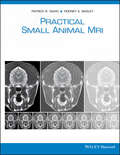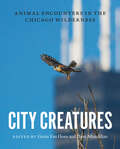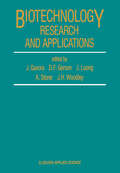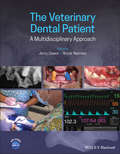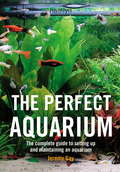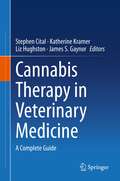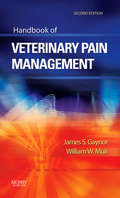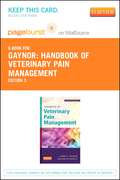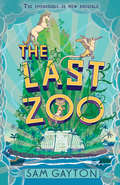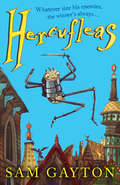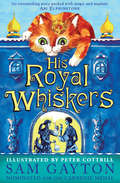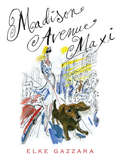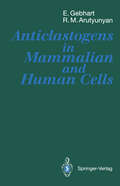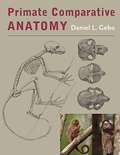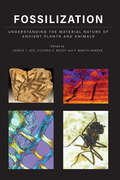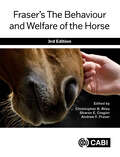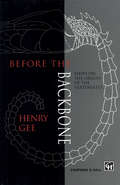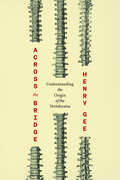- Table View
- List View
Practical Small Animal MRI
by Patrick R. Gavin Rodney S. BagleyPractical Small Animal MRI is the seminal reference for clinicians using Magnetic Resonance Imaging in the diagnosis and treatment of veterinary patients. Although MRI is used most frequently in the diagnosis of neurologic disorders, it also has significant application to other body systems. This book covers normal anatomy and specific clinical conditions of the nervous system, musculoskeletal system, abdomen, thorax, and head and neck. It also contains several chapters on disease of the brain and spine, including inflammatory, infectious, neoplastic, and vascular diseases, alongside congenital and degenerative disorders.
City Creatures: Animal Encounters in the Chicago Wilderness
by Gavin Van Horn and Dave Aftandilian Dave AftandilianWe usually think of cities as the domain of humans—but we are just one of thousands of species that call the urban landscape home. Chicago residents knowingly move among familiar creatures like squirrels, pigeons, and dogs, but might be surprised to learn about all the leafhoppers and water bears, black-crowned night herons and bison, beavers and massasauga rattlesnakes that are living alongside them. City Creatures introduces readers to an astonishing diversity of urban wildlife with a unique and accessible mix of essays, poetry, paintings, and photographs. The contributors bring a story-based approach to this urban safari, taking readers on birding expeditions to the Magic Hedge at Montrose Harbor on the North Side, canoe trips down the South Fork of the Chicago River (better known as Bubbly Creek), and insect-collecting forays or restoration work days in the suburban forest preserves. The book is organized into six sections, each highlighting one type of place in which people might encounter animals in the city and suburbs. For example, schoolyard chickens and warrior wasps populate “Backyard Diversity,” live giraffes loom at the zoo and taxidermy-in-progress pheasants fascinate museum-goers in “Animals on Display,” and a chorus of deep-freeze frogs awaits in “Water Worlds.” Although the book is rooted in Chicago’s landscape, nature lovers from cities around the globe will find a wealth of urban animal encounters that will open their senses to a new world that has been there all along. Its powerful combination of insightful narratives, numinous poetry, and full-color art throughout will help readers see the city—and the creatures who share it with us—in an entirely new light.
City Creatures: Animal Encounters in the Chicago Wilderness
by Gavin Van Horn and Dave Aftandilian Dave AftandilianWe usually think of cities as the domain of humans—but we are just one of thousands of species that call the urban landscape home. Chicago residents knowingly move among familiar creatures like squirrels, pigeons, and dogs, but might be surprised to learn about all the leafhoppers and water bears, black-crowned night herons and bison, beavers and massasauga rattlesnakes that are living alongside them. City Creatures introduces readers to an astonishing diversity of urban wildlife with a unique and accessible mix of essays, poetry, paintings, and photographs. The contributors bring a story-based approach to this urban safari, taking readers on birding expeditions to the Magic Hedge at Montrose Harbor on the North Side, canoe trips down the South Fork of the Chicago River (better known as Bubbly Creek), and insect-collecting forays or restoration work days in the suburban forest preserves. The book is organized into six sections, each highlighting one type of place in which people might encounter animals in the city and suburbs. For example, schoolyard chickens and warrior wasps populate “Backyard Diversity,” live giraffes loom at the zoo and taxidermy-in-progress pheasants fascinate museum-goers in “Animals on Display,” and a chorus of deep-freeze frogs awaits in “Water Worlds.” Although the book is rooted in Chicago’s landscape, nature lovers from cities around the globe will find a wealth of urban animal encounters that will open their senses to a new world that has been there all along. Its powerful combination of insightful narratives, numinous poetry, and full-color art throughout will help readers see the city—and the creatures who share it with us—in an entirely new light.
Biotechnology Research and Applications
by J. Gavora D. F. Gerson J. Luong A. Storer J. H. WoodleyHistorically, ruminant animals have provided farmers with the ability to utilize marginal lands for the production of high quality food for human consumption. Ruminants are able to derive their nourishment from feeds that are not in themselves capable of meeting the nutritional needs of the animal. They do this by supporting in the rumen, which is a greatly enlarged region of the stomach which precedes the animals digestive system, a microbial fermentation system. This system partially degrades complex polysaccharides and provides to the animal not only the degradation products (chiefly volatile fatty acids), but also secondary microbial metabolites and microbial biomass (most importantly microbial protein, which can be synthetized from inorganic nitrogen sources). A ruminant animal is able to survive, if not thrive, on a diet containing only cellulose, a non-protein nitrogen source such as urea, and trace minerals. The capacity of the rumen to process low quality feeds is limited by factors such as rumen volume, the time required for digestion of these feeds in the rumen, and the ability of the animal to chew the feed. Hodern ruminant animals have been intensively selected for high production potential, but the limited capacity of the rumen fermentation means that this potential cannot be realized by feeding the animal low quality feeds. The high production potential of these animals can only be realized by feeding large amounts of readily digestible, high quality feeds such as oilseed meals and grains.
The Veterinary Dental Patient: A Multidisciplinary Approach
by Jerzy Gawor Brook NiemiecProvides an interdisciplinary approach to the veterinary dental patient and offers guidance on all aspects of integrating dentistry into veterinary general practice The Veterinary Dental Patient: A Multidisciplinary Approach helps veterinarians understand the dental aspects of every canine and feline patient and shows them how to effectively manage their oral health. It also provides guidance to the rest of the veterinary team so they can offer a coordinated approach when recommending and performing veterinary dentistry as a regular part of general practice. Edited by two prominent veterinary dentists who are Board Certified in both Europe and the United States, the text includes the latest information on safe anesthetic and monitoring protocols, accurate diagnosis and management, and referring patients to specialists. Chapters cover: establishing a dental presence in general veterinary practice; nutrition, oral health, and feeding dental patients; local, regional, and systemic complications of dental diseases; pain management; ophthalmic considerations; common situations for malpractice and mistakes; oral and maxillofacial surgery; extraction techniques and equipment; drug dosages and more. The book also offers several helpful appendixes. The Veterinary Dental Patient: A Multidisciplinary Approach is an essential book for all vets in general small animal practice as well as the wider veterinary team, including managers, veterinary nurses and technicians, and administrative staff.
The Veterinary Dental Patient: A Multidisciplinary Approach
by Jerzy Gawor Brook NiemiecProvides an interdisciplinary approach to the veterinary dental patient and offers guidance on all aspects of integrating dentistry into veterinary general practice The Veterinary Dental Patient: A Multidisciplinary Approach helps veterinarians understand the dental aspects of every canine and feline patient and shows them how to effectively manage their oral health. It also provides guidance to the rest of the veterinary team so they can offer a coordinated approach when recommending and performing veterinary dentistry as a regular part of general practice. Edited by two prominent veterinary dentists who are Board Certified in both Europe and the United States, the text includes the latest information on safe anesthetic and monitoring protocols, accurate diagnosis and management, and referring patients to specialists. Chapters cover: establishing a dental presence in general veterinary practice; nutrition, oral health, and feeding dental patients; local, regional, and systemic complications of dental diseases; pain management; ophthalmic considerations; common situations for malpractice and mistakes; oral and maxillofacial surgery; extraction techniques and equipment; drug dosages and more. The book also offers several helpful appendixes. The Veterinary Dental Patient: A Multidisciplinary Approach is an essential book for all vets in general small animal practice as well as the wider veterinary team, including managers, veterinary nurses and technicians, and administrative staff.
The Perfect Aquarium: The Complete Guide to Setting Up and Maintaining an Aquarium
by Jeremy GayEverything the first time fish-keeper needs to know to set up a tank. Clear, easy-to-follow instructions help you create and develop your aquarium - whether it's coldwater, tropical or marine. Charts and tables show how to deal with ailments and diseases, and there's a guide to the most common fish. There are profiles of over 100 tropical, marine and coldwater fish, as well as plants and invertebrates.
Cannabis Therapy in Veterinary Medicine: A Complete Guide
by James S. Gaynor Stephen Cital Katherine Kramer Liz HughstonThis book provides in-depth information on the applications of cannabis products as a legitimate medicine in treating a variety of diseases and disorders in domestic animals. Pharmacology and toxicology of cannabinoids and their effects on the endocannabinoid system, which is involved in the regulation of diverse physiological and cognitive processes, are discussed in detail. Furthermore, the book reviews development and testing of cannabis based medical products and introduces the nutritional components of cannabis plants. Cannabis as a therapeutic in veterinary medicine is gaining interest among owners and practitioners. Numerous studies have been completed or are currently underway that analyze the potential of clinical application of cannabinoid and terpenoid molecules. In this book the authors take a comprehensive look at previous studies in animal and human models and discuss translational applications based on these scientific data. This seminal text serves as a go-to resource for veterinary practitioners on cannabinoid therapy. It will also serve as a foundation for clinicians and researchers interested in this emerging field of veterinary medicine.
Handbook of Veterinary Pain Management - E-Book
by James S. Gaynor William W. Muir IIIYou can trust this user-friendly guide to help you meet the increasing need for effective pain management in the animals you treat. It provides instant access to clinically relevant information on pain assessment, pharmaceutical and non-pharmaceutical treatment options, guidelines for managing acute and chronic pain, and unique aspects of pain management in dogs, cats, horses, cattle, birds, reptiles, ferrets, and rabbits.User-friendly format helps you quickly and easily find essential pain management information.Helpful boxes and tables provide at-a-glance access to pharmacologic protocols and clinical applications, including dosages, indications, contraindications, and side effects.Complementary and alternative treatment strategies are included throughout to assist you in using the latest non-pharmacological pain interventions.Case studies clearly illustrate the practical applications of key concepts in the clinical setting and help you sharpen your pain assessment and management skills.New contributors — many of the most respected experts in the field — share their insights and experiences to bring you the most current thinking in this ever-changing discipline.Completely revised and updated content throughout ensures you are using the best and most current information available on analgesic drugs and pain management techniques.An expanded chapter on Pain Management in Horses and Cattle explores the latest advances in treating this group of animals.Eight new chapters offer cutting-edge coverage of hot topics in the field, including:Pain Management in the CatPain Management for the Pet BirdClinical Approaches to Analgesia in ReptilesClinical Approaches to Analgesia in Ferrets and RabbitsPhysical Therapy and Rehabilitation in DogsRehabilitation Methods and Modalities for the CatQuality of Life IssuesHospice and Palliative Care
Handbook of Veterinary Pain Management - E-Book
by James S. Gaynor William W. Muir IIITrust the Handbook of Veterinary Pain Management, 3rd Edition to help you meet the increasing need for effective pain management in the animals you treat. This user-friendly guide contains the most up-to-date and clinically relevant information on analgesic drugs and managing pain in dogs, cats, birds, reptiles, ferrets, and rabbits. It specifically covers the areas of pain assessment, pharmaceutical and non-pharmaceutical treatment options, guidelines for managing acute and chronic pain, and unique aspects of pain management. This edition also incorporates expanded information on cats, exotics, the latest drugs, and more to keep you on top of today’s best practices in veterinary pain management.The latest information on complementary and alternative strategies for pain management offers the guidance to help you incorporate non-pharmacologic treatments into their pain management programs.Numerous boxes and tables summarize pharmacologic protocols and clinical applications, with dosages, indications, contraindications, and side effects to provide you with the comprehensive drug information needed to find the most effective and appropriate treatment.User-friendly format helps you quickly and easily find essential information.Case studies illustrating realistic clinical scenarios help you learn how to assess and manage pain in the clinical setting.NEW! Eight new chapters include the latest information on: the human-animal bondlocal and regional techniquespreventive and multimodal analgesiaenergy modalitiesacupuncturephysical examination with emphasis on isolating and locating paintherapeutic goalspain in laboratory animals NEW! Completely updated drug information, with new agents, doseforms, and routes provides the most current pain management therapies for use in the clinical setting.NEW! Expanded sections on the cat and exotics address the growing popularity of these pets by providing additional species-specific information.
The Last Zoo
by Sam GaytonPia lives in a zoo in the middle of the Pacific Ocean with her parents (both ghosts), several old and cranky genies, a devil, and two young angels. She spends her days trimming genie-beards, trying to avoid being tricked into selling her soul, and waiting for the angels to make a miracle big enough to save the world.Then the angels go missing. Can she solve the riddles of the mysterious haloes the angels have left behind? Is the zoo’s devil really trying to help her? And what does this all have to do with her best friends, the Rekkers? Pia needs to solve the mystery fast, because everything around her seems to be ending: her friendships, her childhood, and maybe even the world itself.
Hercufleas
by Sam Gayton Peter CottrillGreta is a girl on a mission: to venture to Avalon and bring back a hero who can save her home from destruction by the monstrous giant Yuk. Many heroes have tried before now. Many have failed. What Greta needs is a hero whose courage and self-belief are greater than himself. She needs Hercufleas. The only problem: he is a flea, no bigger than a raisin. But the smallest person might just have the biggest effect . . .
His Royal Whiskers
by Sam Gayton Peter CottrillSomething bad has happened to Prince Alexander, the only heir to the mighty Petrossian Empire.Something worse than kidnapping.Something worse than murder.Somehow, the Prince has been miraculously transformed into a fluffy-wuffy kitten.Why has this terrible catastrophe happened?Who are the boy and girl brewing secret potions down in the palace kitchens?And how are they possibly going to avoid getting their heads chopped off?
Madison Avenue Maxi
by Elke GazzaraWhen Ben Gazzara and his wife, Elke, reluctantly agree to adopt the pet dachshund their daughter no longer wants, the couple unknowingly takes a new member into their family. Neither of the Gazzaras is a "dog person," and the sudden presence of a pet in the lives of these jet-setters appears at first uncertain. However, the ever-sweet, playful, and surprisingly smart Maxi immediately endears herself, and soon she becomes the Gazzaras' unlikely "child" in the empty nest of their Madison Avenue townhouse. The little dog accompanies the pair everywhere - to the theater, restaurants, dinner parties, world-class hotels, receptions for heads of state, and even the dentist. Madison Avenue Maxi is the story of a love affair between a dog and her owners. With heartfelt humor and a dog lover's eye, Gazzara chornicles Maxi's antics in Manhattan as well as at their second home in Tuscany and over travels to the French Riviera, Brazil, Spain, and other luxurious locales. Along the way she meets celebrities such as Roman Polanski, Gena Rowlands, John Voigt, Danielle Steele, Gay Talese, Peter Bogdanovich, New York's mayor Michael Bloomberg, and Frank Gehry. Madison Avenue Maxi is a warm, touching memoir of man - and woman's-best friend.
Anticlastogens in Mammalian and Human Cells
by Erich Gebhart Ruben M. ArutyunyanAnticlastogens in Mammalian and Human Cells covers research on the protection of chromosomes from the action of chemical mutagens by use of natural and synthetic antimutagens, which, because of their specific action on clastogenic damage are called anticlastogens. Based on an introductory chapter on nature and mode of formation of chromosome aberrations induced by chemical and also physical mutagens, the action of anticlastogens is discussed in detail. A definition and delineation of the term anticlastogenesis is followed by considerations on the various possibilities of classifying anticlastogens. Attention is paid to the action of anticlastogens in mammalian and human cell culture systems, in vivo data on anticlastogens are presented in great detail, as are the actions of anticlastogens on induced sister chromatid exchanges in various test systems. A mainly historical side-glance at the action of anticlastogens on chromosome damage induced by ionizing radiation is taken. The practical consequences of the findings on anticlastogenic action are extensively discussed as aspects of further research.
Primate Comparative Anatomy (PDF)
by Daniel L. GeboWhy do orangutan arms closely resemble human arms? What is the advantage to primates of having long limbs? Why do primates have forward-facing eyes? Answers to questions such as these are usually revealed by comparative studies of primate anatomy. In this heavily illustrated, up-to-date textbook, primate anatomist Daniel L. Gebo provides straightforward explanations of primate anatomy that move logically through the body plan and across species. Including only what is essential in relation to soft tissues, the book relies primarily on bony structures to explain the functions and diversity of anatomy among living primates. Ideal for college and graduate courses, Gebo's book will also appeal to researchers in the fields of mammalogy, primatology, anthropology, and paleontology. Included in this book are discussions of: * Phylogeny* Adaptation* Body size* The wet- and dry-nosed primates* Bone biology* Musculoskeletal mechanics* Strepsirhine and haplorhine heads* Primate teeth and diets* Necks, backs, and tails* The pelvis and reproduction* Locomotion* Forelimbs and hindlimbs* Hands and feet* Grasping toes
Fossilization: Understanding the Material Nature of Ancient Plants and Animals
by Carole T. Gee Victoria E. McCoy P. Martin SanderUnderstanding the complex interplay of physical and chemical processes leading to fossilization is crucial to elucidating the 3800 million years of life on earth. And yet, the process of fossilization also leads to the loss of pivotal biological information, placing constraints on the very same understanding of ancient life it preserves. Over the last decade, however, remarkable advances in approaches, techniques, tools, and instrumentation have helped scientists to transcend these constraints by enabling high-resolution analysis of fossil material—even down to the nanoscale. Fossilization provides a critical look at these cutting-edge innovations in the science of fossil preservation and provides a road map for future research. Drawing from the fields of paleontology, organic and inorganic chemistry, microbiology, and high-resolution imaging and analysis, and spanning the diversity of life from plants to vertebrates and invertebrates, this resource details expert findings on• fossilization of hard and soft part tissues in dinosaurs• high-resolution chemical analysis of organic and inorganic tissues• arthropods preserved in amber• experimental silicification of wood• chemical defenses and color in fossil plants • confocal Raman spectroscopy• microprobe analysis• radioisotopic studies• and much moreA true interdisciplinary undertaking, the book is authored by paleontologists, mineralogists, geochemists, organic chemists, microbiologists, and materials scientists who have worked together to investigate questions around substance fossilization and the limits of the fossil record. A special color section contains SEM, Raman, and other striking images of vertebrates, invertebrates, and plants. Fossilization is a trailblazing reference book for research scientists and specialists in related fields, as well as for advanced undergraduates and graduate students interested in fossilization, emerging research techniques, and fresh approaches in the analysis of plant and animal fossils.Contributors: H. Jonas Barthel, Aurore Canoville, Carole T. Gee, Thorsten Geisler, Jens Götze, Conrad C. Labandeira, Sashima Läbe, Moritz Liesegang, Victoria E. McCoy, Martina Menneken, Jes Rust, P. Martin Sander, Frank Tomaschek, Torsten Wappler, Kayleigh Wiersma, Tzu-Ruei Yang
Fraser’s The Behaviour and Welfare of the Horse
by Erica K Gee Rebecca Husted Barbara Padalino Gemma Pearson Chris W Rogers Natalie K. WaranThis book continues to provide a comprehensive overview of equine behaviour and an outline of current advances in our understanding, as well as offering insights into contemporary and future challenges for improving horse welfare and safety. Completely updated and revised, a new, international, expert editorial team builds on Andrew Fraser's decades of work as an ethologist, veterinarian, historian, horseman, breeder, trainer, conservationist, and field scientist, sharing essential knowledge to improve horse behaviour and welfare. A range of international experts and key opinion leaders have updated this edition to include the effects of noise on the horse's welfare, husbandry and grazing management including the identification of harmful plants and issues of climate change on pasture. New illustrations and examples bring the book to life and further help to explain equine behaviour in a whole range of different situations, including road transport and horse safety during transport. The text covers key issues concerning equipment and the horse's mouth. It gives new insights into genetics, temperament and horse vocalisations and what these indicate. Welfare assessment models are outlined and the challenges presented in different equestrian sports debated. Difficult topics such as euthanasia are also covered. This classic text remains an essential resource for veterinarians, animal scientists, equine professionals and horse owners.
Before the Backbone: Views on the origin of the vertebrates
by H. GeeWe cannot catechise our stony ichthyolites, as did the necromantic lady of the Arabian Nights did the coloured fishes of the lake which had once been a city, when she touched their dead bodies with her wand, and they straightaway raised their heads and rephed to her queries. We would have many a question to ask them if we could - questions never to be solved. Hugh Miller, The Old Red Sandstone When I started this book in 1991, the subject of vertebrate origins was fusty and unfashionable. Early drafts for this preface read like an extend ed complaint at the lot of traditional morphologists, cast aside by the march of modern molecular biology. But no longer - this book should reach you at a time of renewed inter est in the origin of the vertebrates, our own particular corner of creation. For although the topic has excited interest for well over a century, molec ular biology has only lately achieved the maturity necessary to test its predictions. As a legitimate field of study, it is fashionable again.
Across the Bridge: Understanding the Origin of the Vertebrates
by Henry GeeOur understanding of vertebrate origins and the backbone of human history evolves with each new fossil find and DNA map. Many species have now had their genomes sequenced, and molecular techniques allow genetic inspection of even non-model organisms. But as longtime Nature editor Henry Gee argues in Across the Bridge, despite these giant strides and our deepening understanding of how vertebrates fit into the tree of life, the morphological chasm between vertebrates and invertebrates remains vast and enigmatic. As Gee shows, even as scientific advances have falsified a variety of theories linking these groups, the extant relatives of vertebrates are too few for effective genetic analysis. Moreover, the more we learn about the species that do remain—from sea-squirts to starfish—the clearer it becomes that they are too far evolved along their own courses to be of much use in reconstructing what the latest invertebrate ancestors of vertebrates looked like. Fossils present yet further problems of interpretation. Tracing both the fast-changing science that has helped illuminate the intricacies of vertebrate evolution as well as the limits of that science, Across the Bridge helps us to see how far the field has come in crossing the invertebrate-to-vertebrate divide—and how far we still have to go.
Across the Bridge: Understanding the Origin of the Vertebrates
by Henry GeeOur understanding of vertebrate origins and the backbone of human history evolves with each new fossil find and DNA map. Many species have now had their genomes sequenced, and molecular techniques allow genetic inspection of even non-model organisms. But as longtime Nature editor Henry Gee argues in Across the Bridge, despite these giant strides and our deepening understanding of how vertebrates fit into the tree of life, the morphological chasm between vertebrates and invertebrates remains vast and enigmatic. As Gee shows, even as scientific advances have falsified a variety of theories linking these groups, the extant relatives of vertebrates are too few for effective genetic analysis. Moreover, the more we learn about the species that do remain—from sea-squirts to starfish—the clearer it becomes that they are too far evolved along their own courses to be of much use in reconstructing what the latest invertebrate ancestors of vertebrates looked like. Fossils present yet further problems of interpretation. Tracing both the fast-changing science that has helped illuminate the intricacies of vertebrate evolution as well as the limits of that science, Across the Bridge helps us to see how far the field has come in crossing the invertebrate-to-vertebrate divide—and how far we still have to go.
Across the Bridge: Understanding the Origin of the Vertebrates
by Henry GeeOur understanding of vertebrate origins and the backbone of human history evolves with each new fossil find and DNA map. Many species have now had their genomes sequenced, and molecular techniques allow genetic inspection of even non-model organisms. But as longtime Nature editor Henry Gee argues in Across the Bridge, despite these giant strides and our deepening understanding of how vertebrates fit into the tree of life, the morphological chasm between vertebrates and invertebrates remains vast and enigmatic. As Gee shows, even as scientific advances have falsified a variety of theories linking these groups, the extant relatives of vertebrates are too few for effective genetic analysis. Moreover, the more we learn about the species that do remain—from sea-squirts to starfish—the clearer it becomes that they are too far evolved along their own courses to be of much use in reconstructing what the latest invertebrate ancestors of vertebrates looked like. Fossils present yet further problems of interpretation. Tracing both the fast-changing science that has helped illuminate the intricacies of vertebrate evolution as well as the limits of that science, Across the Bridge helps us to see how far the field has come in crossing the invertebrate-to-vertebrate divide—and how far we still have to go.
Across the Bridge: Understanding the Origin of the Vertebrates
by Henry GeeOur understanding of vertebrate origins and the backbone of human history evolves with each new fossil find and DNA map. Many species have now had their genomes sequenced, and molecular techniques allow genetic inspection of even non-model organisms. But as longtime Nature editor Henry Gee argues in Across the Bridge, despite these giant strides and our deepening understanding of how vertebrates fit into the tree of life, the morphological chasm between vertebrates and invertebrates remains vast and enigmatic. As Gee shows, even as scientific advances have falsified a variety of theories linking these groups, the extant relatives of vertebrates are too few for effective genetic analysis. Moreover, the more we learn about the species that do remain—from sea-squirts to starfish—the clearer it becomes that they are too far evolved along their own courses to be of much use in reconstructing what the latest invertebrate ancestors of vertebrates looked like. Fossils present yet further problems of interpretation. Tracing both the fast-changing science that has helped illuminate the intricacies of vertebrate evolution as well as the limits of that science, Across the Bridge helps us to see how far the field has come in crossing the invertebrate-to-vertebrate divide—and how far we still have to go.
Across the Bridge: Understanding the Origin of the Vertebrates
by Henry GeeOur understanding of vertebrate origins and the backbone of human history evolves with each new fossil find and DNA map. Many species have now had their genomes sequenced, and molecular techniques allow genetic inspection of even non-model organisms. But as longtime Nature editor Henry Gee argues in Across the Bridge, despite these giant strides and our deepening understanding of how vertebrates fit into the tree of life, the morphological chasm between vertebrates and invertebrates remains vast and enigmatic. As Gee shows, even as scientific advances have falsified a variety of theories linking these groups, the extant relatives of vertebrates are too few for effective genetic analysis. Moreover, the more we learn about the species that do remain—from sea-squirts to starfish—the clearer it becomes that they are too far evolved along their own courses to be of much use in reconstructing what the latest invertebrate ancestors of vertebrates looked like. Fossils present yet further problems of interpretation. Tracing both the fast-changing science that has helped illuminate the intricacies of vertebrate evolution as well as the limits of that science, Across the Bridge helps us to see how far the field has come in crossing the invertebrate-to-vertebrate divide—and how far we still have to go.
Across the Bridge: Understanding the Origin of the Vertebrates
by Henry GeeOur understanding of vertebrate origins and the backbone of human history evolves with each new fossil find and DNA map. Many species have now had their genomes sequenced, and molecular techniques allow genetic inspection of even non-model organisms. But as longtime Nature editor Henry Gee argues in Across the Bridge, despite these giant strides and our deepening understanding of how vertebrates fit into the tree of life, the morphological chasm between vertebrates and invertebrates remains vast and enigmatic. As Gee shows, even as scientific advances have falsified a variety of theories linking these groups, the extant relatives of vertebrates are too few for effective genetic analysis. Moreover, the more we learn about the species that do remain—from sea-squirts to starfish—the clearer it becomes that they are too far evolved along their own courses to be of much use in reconstructing what the latest invertebrate ancestors of vertebrates looked like. Fossils present yet further problems of interpretation. Tracing both the fast-changing science that has helped illuminate the intricacies of vertebrate evolution as well as the limits of that science, Across the Bridge helps us to see how far the field has come in crossing the invertebrate-to-vertebrate divide—and how far we still have to go.
